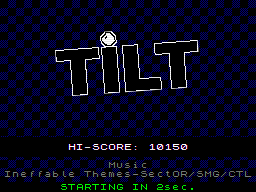Tilt
Marble Maze, © KesieV 2018

One of the best things of a capitalist society is that you can get a glimpse of its culture just looking inside its product packages. Consumer technology exploded during the modern free-market age so peeking inside that boxes should produce more clear readings. But we don't need a clever reason for talking about tech stuff... we're just a bunch of nerds, amarite? I'm going to use Italy's launch dates and basic editions as references, okay?
The Commodore 64 came in 1983 and if you're following my Wright! adventures, you already know that's one of my favourite gaming machines. Let's unbox it: there is a user guide (which mainly was a BASIC textbook), few cables, a VHF switch, a weighty power supply box and the iconic breadbox keyboard. No built-in software - except for the BASIC interpreter - and no games nor game controllers.
The third generation of gaming consoles was just started and, into the NES box ("il Nintendo" as we called it) of 1987, we found: the usual cables, a light gun, a game cart with the marvellous Super Mario Bros. and the iconic Duck Hunt, two controllers and power supply box.
We have the same packaging for the next generation of gaming console but then... the first PlayStation came, in 1995. What's in the box? Cables, console, a user's manual, a single game controller and a software disc. The flagship built-in game disappeared, replaced by a disc containing no full games but a collection of selected game demos.
It may look like a greedy Sony decision but it actually defined (or described) a trend: the next generation of consoles of 2002 Nintendo did even worse. In the Nintendo Gamecube box there were just the mandatory cables and power supply box, a game controller, a game catalog, the console itself and... that's all. Out of the box, the gaming console was just a pile of plastic.
That's enough for now.
When computers were personal I think that was okay to sell just the computer itself and a manual that explains how to make it work for you. We talked about that before. It was like purchasing an Arduino today.
But looks like that people just want things to get done instead of studying how things works. And that's okay - we don't have to know how to put together a car in order to productively use a car. But consumers have to at least understand the product qualities by their own. And that's why the best available software appeared in the box.
And then... it disappeared. Why? Consumers probably started to be aware of how computers and consoles work and have some sort of taste of games. And that's crucial for capitalism: taste is the best thing that joins a product to its value - affective or monetary. So... no good free software for you, consumers. You've to earn it.
And that's okay and pretty straightforward. What's not is the consecutio temporum behind these facts: are the people who purchased the first home computers truly the same of the console one? Is the consumer awareness of a product a measurement of its knowledge of the technology behind that?
Why I am doubtful? Well... because when the first iPhone came out in 2009 we felt a mix of hype and confusion about the bunch of sensors we've just purchased and we were blindly looking for answers in the Appstore. But, in the middle of the misleading software forest, we found the answer in a game we probably all played at least once: tilting the phone in order to make a ball rolling to its goal finally explained to us what immersivity really is and the value of accelerometers.
Thank you, ball rolling game!
Plot!
There is a ball rolling in a maze... tilt your mobile device and reach the goal!
No keyboard this time: tilt your mobile device for making the ball roll!
(Want to share something? You can find me on Twitter!)
 Install / Add to home
Install / Add to home
 View game sources
...or play it online below!
View game sources
...or play it online below!